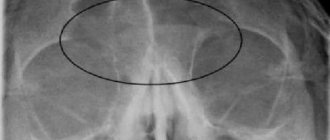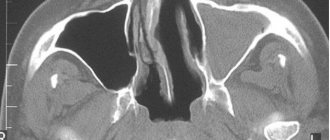There are contraindications. Specialist consultation is required.
Deviated nasal septum: how it occurs Causes Symptoms Types of curvature of the nose Consequences Diagnosis Deviated nasal septum: treatment
One of the common problems that ENT doctors encounter at appointments is varying degrees of curvature of the nasal septum. Often it is deviated in one or both directions at once (complex deformation of the nasal septum in the area of bone or cartilage), due to which nasal breathing is greatly affected. It can become very difficult to the point of complete inability to breathe through the nose, and this in turn leads to serious complications in the respiratory tract and throughout the body.
According to statistics, the pathology is more common among adults, and men are more likely to suffer from severe curvatures than women.
Deviated nasal septum: how does it occur?
When a child is born, the nasal septum consists of separate sections of cartilage tissue. As they grow, some of the islets ossify, grow together, form an osteochondral base, which serves as a support, and forms the lumen of the nasal passages. But during development, problems may arise caused by injuries or other factors. Then the islands of cartilage can shift, overlapping one another, causing an arched deformity that makes breathing through the nose difficult.
It is important to understand how the curvature of the nasal septum affects: the speed and volume of air flow when inhaling changes, the mucous membrane is constantly irritated, the work of the paranasal sinuses and the nasopharynx area is affected, which leads to tissue swelling, narrowing of the openings in the nasal concha, maxillary sinuses and the Eustachian tube area. Although a person gets used to such breathing, he constantly feels discomfort and often suffers from various ENT pathologies and respiratory diseases and infections.
Postoperative course
First day. After leaving the operating room, the patient will need to breathe through his mouth as the nose will be filled with tampons. A sling-shaped bandage will also be applied to the nose, which will need to be changed as soon as it becomes saturated with ichor. Due to forced breathing through the mouth, the oral mucosa may become dry. To avoid this, it is advisable to drink more fluid. For the first time after surgery, it is recommended to limit physical activity and avoid hot drinks and food. From the first day, the patient is given an intramuscular injection of antibiotics and is given sleeping pills and painkillers before going to bed.
Second day. On the second day after surgery, the tamponade is removed, which leads to slight bleeding. To eliminate it, a sling-shaped bandage is put on.
Subsequent rehabilitation. From the third day, treatment consists of daily cleaning of the nasal cavity from formed crusts and lubricating the nasal mucosa with Vaseline oil.
Typically, crusts stop forming a few weeks after surgery. Then the swelling of the mucous membrane disappears and breathing through the nose is restored. One to two weeks after the operation, the patient returns to work, but physical activity is contraindicated for a month.
If the curvature is accompanied by an exacerbation of a chronic inflammatory disease of the ENT organs, the chronic disease is first treated and only two weeks after the exacerbation is eliminated, surgery is performed to correct the curvature.
Since septoplasty is accompanied by blood loss, women are recommended to undergo surgery in the second week after the end of menstruation.
Causes
Usually the pathology is determined by an ENT doctor. Experts identify several causes of deformation, divided into groups.
There is a congenital curvature of the nose, which is directly related to a violation of the anatomy in utero, cartilage defects or problems with the development of the facial skeleton in utero.
Physiological deformation is the most common cause. During the growth process, cartilage or bone structures may develop unevenly, some tissues develop ahead or behind. Because of this, curvature is formed.
The consequence of injuries is another common reason for which the diagnosis of a deviated nasal septum is formed. Usually these are blows to the nose, broken bones, or sports injuries.
Also, specialists often identify signs of a deviated nasal septum in ENT pathologies: polyps, hypertrophy in the area of the inferior conchae, the presence of foreign bodies, against the background of rickets or syphilis, and autoimmune processes.
Operation to straighten the nasal septum: preparation and implementation
Preparation for surgery includes the necessary examinations:
- blood tests (general, biochemistry, determination of blood clotting, etc.);
- testing for HIV and hepatitis;
- ECG, fluorography;
- physical examination and rhinoscopy of the nasal cavity;
- endoscopy of the nose and CT scan of the sinuses;
- rhinomanometry (respiratory function test).
To identify contraindications, consultation with a therapist, otolaryngologist, and anesthesiologist is necessary. The patient must notify the doctor about past illnesses, medications taken, and allergies.
Before surgery, you must stop taking medications that thin the blood, avoid drinking alcohol, and refrain from smoking. The anesthesiologist will select the method of pain relief taking into account the type of septoplasty, the patient’s health condition, and the presence of contraindications.
Progress of the operation
After administering anesthesia or applying local anesthesia, the surgeon makes incisions inside the nasal cavity, peels off the mucous membrane, removes deformed areas of cartilage or bone tissue, corrects them and reimplants them back, installing them in the required position. Having eliminated the deformity, the surgeon places special silicone plates on the nasal septum - splints, fixing them with sutures, and inserts small rubber tampons into the nasal passages. They are designed to hold the septum in the correct position and prevent bleeding. Before the tampons are removed, the patient will have to breathe through the mouth or through special tubes.
More modern endoscopic techniques make it possible to make minimal incisions, resulting in faster recovery after surgery, and the risk of complications is minimized. The cost of correcting a nasal septum depends on the method of surgery, the degree of complexity of the defect, and the type of anesthesia used.
Consultation with an otorhinolaryngologist
| Primary consultation with an otorhinolaryngologist | 7 800 tenge |
| Repeated consultation with an otorhinolaryngologist | 6 500 tenge |
| Inspection | 4 500 tenge |
See all prices
Symptoms
Among the key signs of curvature of the cartilaginous or bony area of the nasal septum, doctors identify:
- difficulty breathing through the nose (one nostril or both, depending on the type of deformity);
- frequent occurrence of sinusitis due to impaired air circulation inside the sinuses, difficulty in separating mucous secretions, stagnation and the addition of pathogenic flora;
- loud snoring throughout the night, development of obstructive apnea (pauses during breathing during sleep), transition to mouth breathing;
- severe dryness of the mouth and nose due to the fact that the stage of purification, heating of the inhaled air suffers, it is not sufficiently moistened;
- changing the shape of the tip and back, the entire nose.
Against the background of a deviated nasal septum, general symptoms are also possible - signs of tissue hypoxia, the presence of anemia and weakness, and decreased performance. Frequent colds (pharyngitis, tonsillitis, laryngitis) are typical due to the transition to mouth breathing, and due to drying out, thinning and injury to the nasal mucosa - bleeding.
ENT treatment of adenoids, polyps and deviated nasal septum
Author of the article: Latysheva Elena Nikolaevna, pediatric otorhinolaryngologist, otorhinolaryngologist
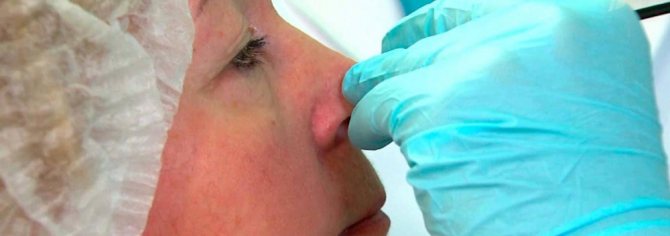
Deviated nasal septum
A deviated nasal septum can manifest itself as deviation from the midline, the formation of septal spines and ridges, which narrow the nasal passages and thereby make nasal breathing difficult. Deformation of the nasal septum can occur due to a discrepancy in the growth of its bone and cartilaginous parts, as well as as a result of injury. A deviated nasal septum can be identified in a large percentage of people, but it does not impair nasal breathing in everyone.
Symptoms
The main complaint of patients with deformed nasal septum is difficulty in nasal breathing and nasal congestion. Other symptoms may include headache, nasal dryness and crusting, nasal discharge, snoring, and episodes of sleep apnea. In case of colds, a deviated septum contributes to the development of the inflammatory process in the paranasal sinuses, as well as the auditory tube and middle ear. Sometimes patients with a deviated nasal septum are forced to constantly use vasoconstrictor drops, which in turn leads to congestion in the nasal mucosa and reduces the lumen of the airways.
Diagnostics
The diagnosis is made during a standard examination of the nasal cavity (anterior rhinoscopy). If a concomitant inflammatory process in the paranasal sinuses is suspected, a computed tomography scan of the paranasal sinuses is required.
Treatment
Treatment of a deviated nasal septum is surgical. The operation is called septoplasty and consists of removing curved sections of the nasal septum while preserving the osteochondral structures as much as possible. If there are small ridges or spines on the nasal septum, a smaller operation is performed - cristotomy under endoscopic control. In the presence of concomitant diseases of the sinuses (chronic sinusitis, cysts, polyps, etc.), an intervention is performed on the paranasal sinuses at the same time.
The operation is performed in a hospital with hospitalization for a day. Septoplasty can be performed under general anesthesia or local anesthesia. The duration of the operation is on average 30-40 minutes. The day after surgery, elastic tampons are placed in the nasal cavity. Postoperative recovery takes on average up to 2 weeks.
Nasal polyps (polypous rhinosinusitis)
Polypous rhinosinusitis is characterized by chronic inflammation of the mucous membrane of the nasal cavity and paranasal sinuses and the recurrent formation of polyps consisting of edematous tissue with cellular infiltration. In the general population, the prevalence of polyposis rhinosinusitis is 0.5-4.3%[1]. Often (up to 70%) polypous sinusitis is combined with bronchial asthma and intolerance to aspirin (non-steroidal anti-inflammatory drugs). The combination of all three pathologies is called the aspirin triad. The polypous process with the aspirin triad has a more persistent and severe course and less effectiveness of both conservative therapy and surgical interventions. Despite active scientific research, the cause of polyposis rhinosinusitis has not yet been established, and the number of patients continues to increase.
Symptoms
The main complaint of patients with nasal polyps is difficulty in nasal breathing, the degree of which depends on the size of the polyps. You may also be concerned about a decreased sense of smell, up to its complete absence, mucous and mucopurulent discharge from the nose, and headache. Complaints will intensify with the addition of an inflammatory process in the nasal cavity and paranasal sinuses.
Diagnostics
Nasal polyps are detected during a routine examination of the nasal cavity (anterior rhinoscopy). To determine the extent of the process in the paranasal sinuses and the extent of the operation, a computed tomography scan is necessary.
Treatment
Treatment is aimed at eliminating the cause of the symptoms - removing polyps and creating normal aeration of the paranasal sinuses and access for nasal corticosteroids.
For small polyps of the nasal cavity, it is possible to carry out drug therapy with nasal and systemic corticosteroids in courses for several months.
For large polyps, as well as a pathological process in the paranasal sinuses, endoscopic polysinsotomy is performed. During the operation, under endoscopic control, with the help of forceps and a microdebrider, polyps are removed from the nasal passages, the block of anastomoses of the paranasal sinuses is eliminated, the anastomosis is expanded to a size sufficient to cleanse the sinuses, and polyps and discharge are also removed from the sinuses. The operation is performed while maintaining the normal anatomy and function of the nose. This type of surgery is called functional endoscopic sinus surgery.
If major surgery is contraindicated for the patient due to concomitant diseases, you can limit yourself to only removing polyps (edoscopic polypotomy).
In the postoperative period, after the reactive phenomena have subsided, the patient is also prescribed a course of treatment with nasal corticosteroids for up to 3 months.
Adenoids
In the nasopharynx in childhood and adolescence there is a pharyngeal tonsil. Enlarged pharyngeal tonsils are called adenoids. Depending on the degree of enlargement, adenoids of grades I, II and III are distinguished. If the tissue of the pharyngeal tonsil is in a state of inflammation, we speak of adenoiditis. During the process of growing up, the pharyngeal tonsil undergoes involution and is rare in adults.
Symptoms
Adenoids cause difficulty in nasal breathing, snoring, episodes of sleep apnea, nasal discharge, hearing impairment, and inflammatory processes in the paranasal sinuses and middle ear. Lack of oxygen in the blood over time can lead to physical and mental retardation in the child. In addition, with the duration of the disease, deformations occur in the facial skeleton (a half-open mouth with a shortened upper lip, smoothness of the nasolabial folds, slightly exophthalmic and sedentary eyes, abnormal development of the dental system, characterized by protruding and unevenly spaced incisors, a narrow and high (Gothic) palate).
Diagnostics
Complaints and data about the disease are sufficient to suggest that the child has adenoids. An examination of the nasal cavity and nasopharynx and an endoscopic examination of the nasopharynx are performed. If an inflammatory process in the paranasal sinuses is suspected, radiography or computed tomography is performed.
Treatment
Conservative treatment consists of rinsing the nasal cavity and nasopharynx with saline solutions and antiseptic drugs, using local inhaled corticosteroid drugs, silver preparations (collargol, protargol) and much more.
Surgery
In case of ineffectiveness of conservative treatment, and complications such as exudative otitis media or sinusitis, surgical removal of the adenoids is indicated. Endoscopic adenotomy is performed under endotracheal anesthesia. Under endoscopic control, adenoids are removed using an adenotome or microdebrider. Endoscopic control allows you to completely remove the adenoid tissue and stop bleeding. The operation is performed in a hospital with hospitalization for a day. In the presence of concomitant hypertrophy of the palatine tonsils, adenotonsillotomy is performed.
Making an appointment with an otolaryngologist
Be sure to consult a qualified specialist in the field of ENT diseases at the Semeynaya clinic.
Single contact center
8 495 662-58-85
daily from 8 to 21
To find out the prices for an otolaryngologist appointment or other questions, please follow the link below
Otolaryngology
Types of nasal deformity
Experts distinguish several types or stages of deviated nasal septum. Alternatively, there may be deformation in the septum area, damage to the ridge or spine, or problems in the cartilaginous or bone part.
Doctors often classify the problem based on how a deviated nasal septum looks. For example, there may be a C-shaped or S-shaped septum, problems, the formation of a spike or ridge, complex combinations after injuries that do not fit into standard classifications.
Surgical treatment (septoplasty)
Septoplasty is performed in several stages.
The patient is injected subperichondrially with local infiltration anesthesia into the nasal septum. Sometimes the operation is performed under general anesthesia.
Then, an incision is made in the skin of the nasal septum.
The mucous membrane is separated (peeled off) on the sides of the nasal septum.
The curved parts are separated from the quadrangular cartilage and the bony part of the septum.
After removing the curved parts, stitches are applied.
Upon completion of the operation, nasal tamponade is performed with finger swabs for a period of 24 hours.
Diagnostics
To decide on the question of how to treat a deviated nasal septum, you need to make a correct diagnosis. An examination by an ENT doctor, rhinoscopy and additional tests are indicated.
During the examination, the doctor evaluates the nose by appearance, checks nasal breathing separately for each nostril using a cotton swab (its villi oscillate). In addition, the specialist also evaluates the level of smell; if there are problems with the septum, the sense of smell decreases.
Rhinoscopy is a visual examination of the nasal cavity using a number of instruments (mirrors, spatulas). Anterior rhinoscopy determines the condition of the mucosa and the presence of formations (hematomas, polyps, tumors or abscesses).
During posterior rhinoscopy, the nasal area is examined using a spatula and mirrors from the side of the pharynx.
Additionally, to diagnose septum problems, an X-ray of the skull is performed, assessing the condition of the nasal sinuses and checking the correct development of the bones. Your doctor may recommend a CT scan of the skull to determine complex deformities. Additionally, an endoscopic examination of the nose and pharynx can be performed using flexible instruments.
Indications and contraindications for surgery
Surgical intervention is used in the following situations:
- constant nasal congestion;
- persistent difficulty breathing;
- impaired sense of smell;
- frequent headaches;
- chronic ENT pathologies (sinusitis, pharyngitis);
- dry nasal cavity, frequent bleeding;
- night apnea.
The operation is contraindicated if:
- the patient suffers from acute infectious, oncological, autoimmune diseases;
- there are problems with blood clotting;
- Chronic diseases are getting worse.
In addition, the intervention is not carried out in case of uncontrolled diabetes mellitus, pregnancy and lactation.
Septoplasty. Description of modern techniques
Endoscopic septoplasty
- Our clinic has modern equipment that allows for gentle surgical intervention. Also at your service are experienced doctors who are fluent in the technique of performing endoscopic septoplasty.
How is it carried out?
- The doctor performs resection of deformed areas of the septum. In some cases, fragments of cartilage tissue are removed, and this is done in such a way as not to affect the supporting function of the septum. The duration of endoscopic septoplasty is approximately 1-1.5 hours. The use of local, general and combined anesthesia is allowed. There are no traces of surgery left on the patient’s face. The operation ends with the installation of hemostatic tampons and special fixatives in the nose, which are removed after a day. Typically, the patient does not need to stay in the clinic for more than 24 hours. Complete restoration of nasal breathing is observed on days 5-7.
Price for surgery to correct (align) the nasal septum
Septoplasty is a rather technically complex operation that requires the surgeon to have extensive experience and high qualifications. The ENT practice clinic employs highly qualified specialists who use the most modern equipment to perform operations to eliminate anatomical defects.
Have you decided to correct your nasal septum? The price for the procedure is quite reasonable; you can find the price list for services on the clinic’s website. Make an appointment with a doctor and come for a diagnostic examination! We will definitely help you!
Recovery
Rehabilitation after septoplasty takes from 1 to 4 weeks. During this time, postoperative swelling subsides and breathing is completely restored. After low-traumatic interventions using endoscopic equipment, the patient can go home the next day. Tampons from the nostrils are removed after one day. The sutures on the mucous membrane heal quickly, but complete recovery will take about a month.
During the recovery period, the following recommendations must be followed:
- Do not touch your nose, blow your nose, or remove tampons yourself;
- You should not drink in the first 2 hours after surgery, then it is recommended to increase the volume of fluid you drink to 2–2.5 liters per day;
- It is better to avoid tilting your head;
- you should stop wearing glasses;
- you need to stay in bed and avoid physical activity;
- It is advisable to wear clothes with buttons without taking them off over your head;
- avoid smoking and alcohol, avoid fatty and salty foods that cause swelling.
After removing the tampons, it is necessary to rinse the nasal cavity with a saline solution prescribed by the doctor.

Make an appointment online
Without queues and long waits, at a time convenient for you to see any doctor
Sign up
What happens when the nasal septum is deformed?
There is such a thing as nasal resistance. It implies that the intranasal structures resist the air flow that passes through the nose. The degree of such resistance changes every 5-6 hours. In other words, we alternately breathe with the right and then the left half of the nose. At the same time, thanks to the symmetrically located nasal septum, the air is distributed evenly between both halves. Therefore, a person does not notice this cycle.
If the septum is deviated, nasal resistance increases in the narrow half. At the same time, the wide half of the nose is overloaded, because it is through it that the bulk of the air begins to pass. This may lead to the development of chronic rhinitis, which, in turn, leads to hypertrophy (proliferation) of the mucous membrane. Source: Kumar L, Belaldavar BP, Bannur H. Influence of Deviated Nasal Septum on Nasal Epithelium: An Analysis // Head Neck Pathol. 2021 Dec;11(4):501-505. doi:10.1007/s12105-017-0819-9. Epub 2021 May 4.
Consequences and complications of the disease if surgery is not performed
A deviated nasal septum is certainly not life-threatening. However, this defect causes certain health problems. Researchers have proven that impaired nasal breathing leads to a 10-15% decrease in the amount of oxygen received by the brain. This circumstance cannot but affect the working capacity of adults and the intellectual development of children. In addition, there are disruptions in the functioning of the body's cardiovascular and hematopoietic systems. Immune problems may occur, increasing the risk of respiratory diseases.
Septoplasty - before and after photos
Rhino-septoplasty of the nasal dorsum.
Patient I., 27 years old.
The patient had an injury 5 years ago. Before the operation, there was deformation of the nasal bridge and difficulty in nasal breathing.
A combined operation was performed: rhinoplasty and septoplasty. This operation is performed at the ViTerra clinic by otolaryngologist and plastic surgeons simultaneously. Since the format of a multidisciplinary clinic allows this intervention to be performed with maximum clinical effect, the operation was performed in the minimum time and in the most comfortable conditions for the patient. A modern operating room and leading anesthesiologists in Moscow allow us to avoid all possible complications during this combined operation.
Photo before
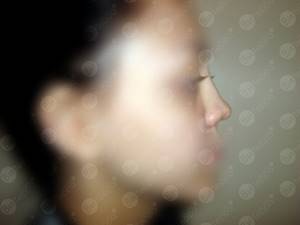
Photo after, 3 months later.
Complete recovery and pronounced aesthetic effect.
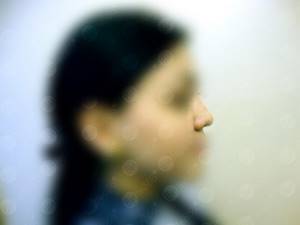
The cost of the operation together with anesthesia + observation in a day hospital was: 148,000 rubles .
Difficulty in nasal breathing and visually pronounced deformation of the nasal bridge
Patient I., 43 years old.
Was injured as a result of an accident. The patient was bothered by difficulty in nasal breathing and visually pronounced deformation of the nasal bridge.
A combined operation was performed at the ViTerra clinic: rhinoplasty, septoplasty.
Photo before

Photo after, after 3 weeks
The patient was discharged with positive cosmetic and functional results.
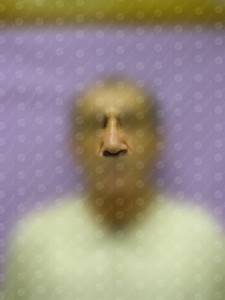
The total cost of treatment and observation in our clinic was: 180,000 rubles.
Deformation of the external nose, hump of the nasal bridge, difficulty in nasal breathing
Patient E., 35 years old.
I had a nose injury about 5 years ago. The diagnosis made by doctors: deformation of the external nose, hump of the nasal bridge, difficulty in nasal breathing.
An operation was performed: rhinoplasty + septoplasty. After completing the treatment in our clinic, a pronounced aesthetic and physiological effect was observed.
Photo before

Photo after, 4 weeks
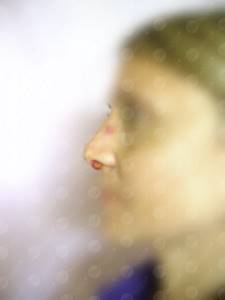
Photo after, 4 weeks
Photo after, after 6 months
The cost of treatment was: 180,000 rubles.



